

Compact Muon Solenoid
LHC, CERN
| CMS-HIN-15-013 ; CERN-EP-2017-002 | ||
| Study of jet quenching with Z+jet correlations in PbPb and pp collisions at $\sqrt{ s_{\mathrm{NN}} } = $ 5.02 TeV | ||
| CMS Collaboration | ||
| 3 February 2017 | ||
| Phys. Rev. Lett. 119 (2017) 082301 | ||
| Abstract: The production of jets in association with Z bosons, reconstructed via the $\mu^{+}\mu^{-}$ and $\mathrm{ e }^{+}\mathrm{ e }^{-}$ decay channels, is studied in pp and, for the first time, in PbPb collisions. Both data samples were collected by the CMS experiment at the LHC, at a center-of-mass energy of 5.02 TeV. The PbPb collisions were analyzed in the 0-30% centrality range. The back-to-back azimuthal alignment was studied in both pp and PbPb collisions for Z bosons with transverse momentum $ p_{\mathrm{T}}^{\mathrm{Z}} > $ 60 GeV/$c$ and a recoiling jet with $ p_{\mathrm{T}}^{\text{jet}} > $ 30 GeV/$c$. The $p_{\mathrm{T}}$ imbalance, $ x_{\mathrm{jZ}}= p_{\mathrm{T}}^{\text{jet}}/p_{\mathrm{T}}^{\mathrm{Z}}$, as well as the average number of jet partners per Z, $ R_{\mathrm{jZ}} $, were studied in intervals of $p_{\mathrm{T}}^{\mathrm{Z}}$, in both pp and PbPb collisions. The $R_{\mathrm{jZ}}$ is found to be smaller in PbPb than in pp collisions, which suggests that in PbPb collisions a larger fraction of partons, associated with the Z bosons, lose energy and fall below the 30 GeV/$c$ $ p_{\mathrm{T}}^{\text{jet}} $ threshold. | ||
| Links: e-print arXiv:1702.01060 [hep-ex] (PDF) ; CDS record ; inSPIRE record ; HepData record ; CADI line (restricted) ; | ||
| Figures | Summary | Additional Figures | References | CMS Publications |
|---|
| Cover | |

png ; pdf |
Cover of Physical Review Letters, Volume 119, Number 8, published August 25, 2017. |
| PRL Editor's Suggestion, Featured in Physics, August 23, 2017 | |
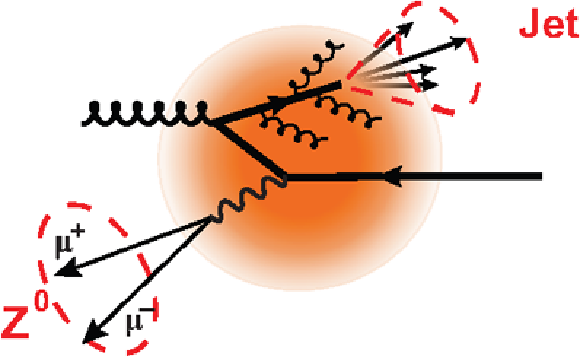
png |
(not a CMS figure) Figure from ``Synopsis: A Precise Probe of the Quark-Gluon Plasma'', by Katherine Wright. Properties of the quark-gluon plasma can be inferred from measurements of jets and Z bosons simultaneously produced in the ion collisions that create the plasma. |
| Figures | |

png pdf |
Figure 1:
Invariant mass distributions of the selected dimuons (top) and dielectrons (bottom), compared to PYTHIA+HYJET ${\mathrm{ Z } } (\ell \ell )$+jet events. The MC histogram is normalized to the number of events in the data. |
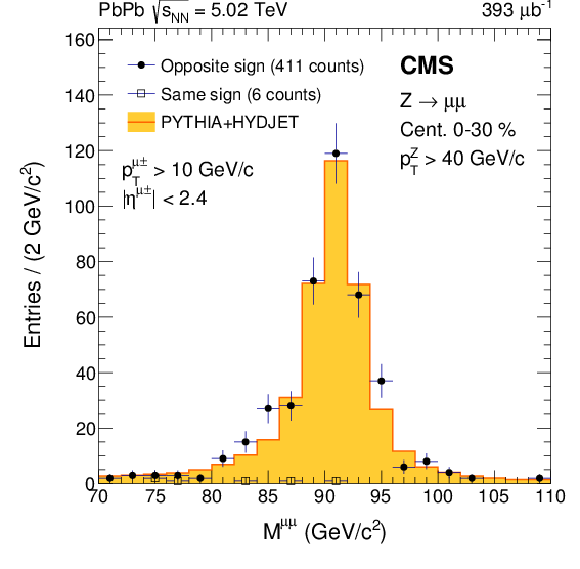
png pdf |
Figure 1-a:
Invariant mass distributions of the selected dimuons (top) and dielectrons (bottom), compared to PYTHIA+HYJET ${\mathrm{ Z } } (\ell \ell )$+jet events. The MC histogram is normalized to the number of events in the data. |

png pdf |
Figure 1-b:
Invariant mass distributions of the selected dimuons (top) and dielectrons (bottom), compared to PYTHIA+HYJET ${\mathrm{ Z } } (\ell \ell )$+jet events. The MC histogram is normalized to the number of events in the data. |
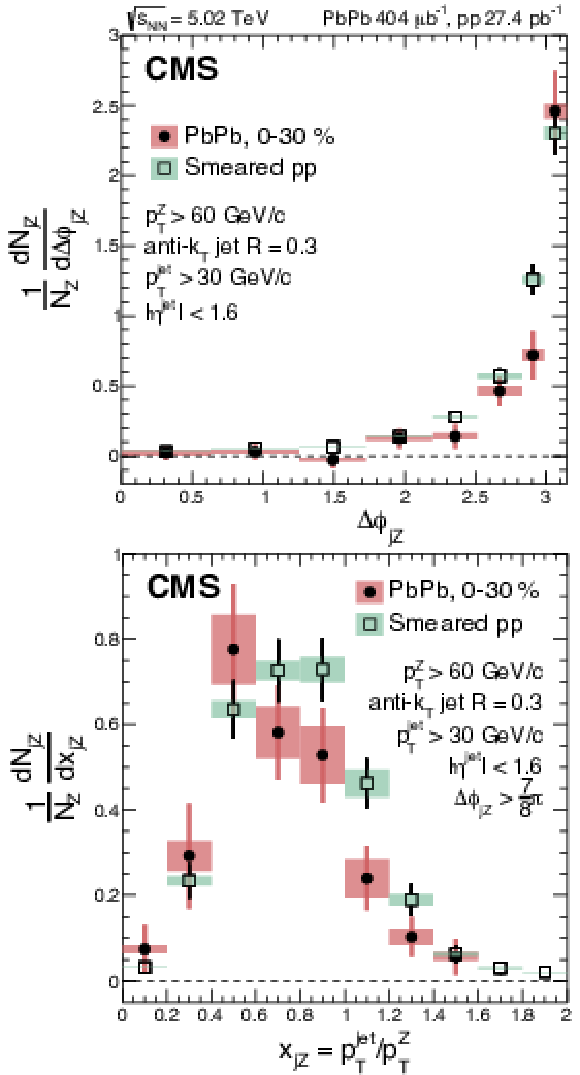
png pdf |
Figure 2:
Distributions of the azimuthal angle difference ${\Delta \phi _{\mathrm {jZ}}} $ between the Z boson and the jet (top), and of the transverse momentum ratio ${x_{\mathrm {jZ}}}$ between the jet and the Z boson with $ {\Delta \phi _{\mathrm {jZ}}} > 7 \pi /8$ (bottom). The distributions are normalized by the number of Z events, $N_{{\mathrm{ Z } } }$. Vertical lines (bands) indicate statistical (systematic) uncertainties. |
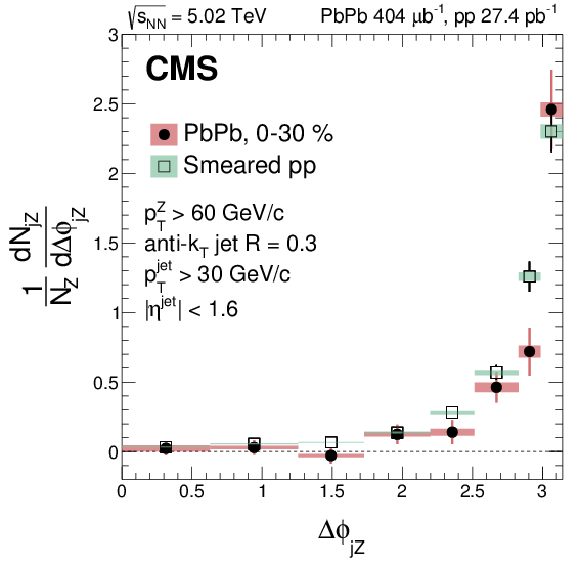
png pdf |
Figure 2-a:
Distributions of the azimuthal angle difference ${\Delta \phi _{\mathrm {jZ}}} $ between the Z boson and the jet (top), and of the transverse momentum ratio ${x_{\mathrm {jZ}}}$ between the jet and the Z boson with $ {\Delta \phi _{\mathrm {jZ}}} > 7 \pi /8$ (bottom). The distributions are normalized by the number of Z events, $N_{{\mathrm{ Z } } }$. Vertical lines (bands) indicate statistical (systematic) uncertainties. |

png pdf |
Figure 2-b:
Distributions of the azimuthal angle difference ${\Delta \phi _{\mathrm {jZ}}} $ between the Z boson and the jet (top), and of the transverse momentum ratio ${x_{\mathrm {jZ}}}$ between the jet and the Z boson with $ {\Delta \phi _{\mathrm {jZ}}} > 7 \pi /8$ (bottom). The distributions are normalized by the number of Z events, $N_{{\mathrm{ Z } } }$. Vertical lines (bands) indicate statistical (systematic) uncertainties. |
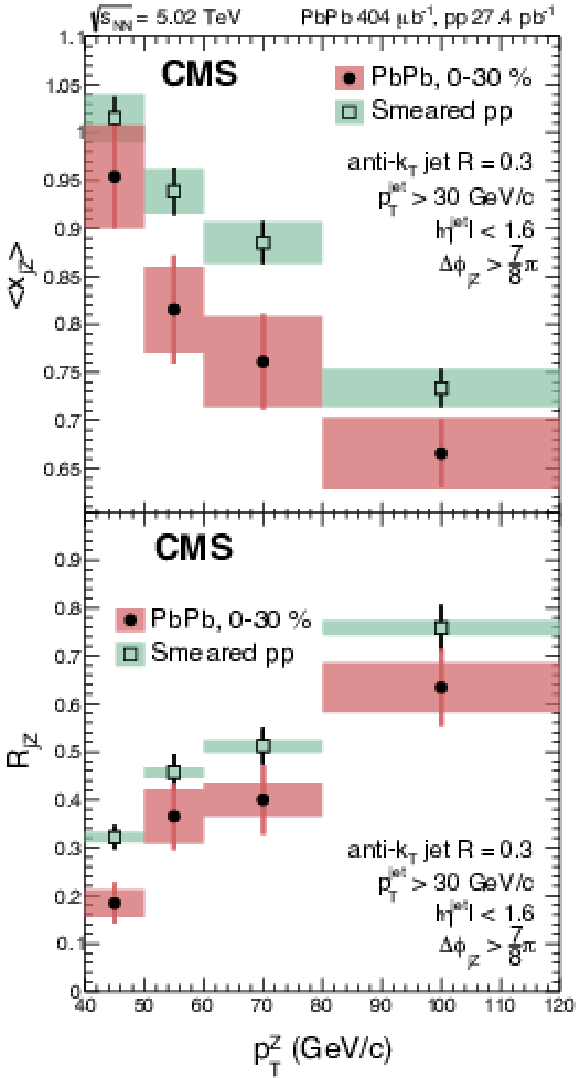
png pdf |
Figure 3:
The mean value of the $ {x_{\mathrm {jZ}}} $ distribution (top) and the average number of jet partners per Z boson $ {R_{\mathrm {jZ}}} $ (bottom), as a function of ${p_{\mathrm {T}}^{{\mathrm{ Z } } }} $. Vertical lines (bands) indicate statistical (systematic) uncertainties. |

png pdf |
Figure 3-a:
The mean value of the $ {x_{\mathrm {jZ}}} $ distribution (top) and the average number of jet partners per Z boson $ {R_{\mathrm {jZ}}} $ (bottom), as a function of ${p_{\mathrm {T}}^{{\mathrm{ Z } } }} $. Vertical lines (bands) indicate statistical (systematic) uncertainties. |

png pdf |
Figure 3-b:
The mean value of the $ {x_{\mathrm {jZ}}} $ distribution (top) and the average number of jet partners per Z boson $ {R_{\mathrm {jZ}}} $ (bottom), as a function of ${p_{\mathrm {T}}^{{\mathrm{ Z } } }} $. Vertical lines (bands) indicate statistical (systematic) uncertainties. |
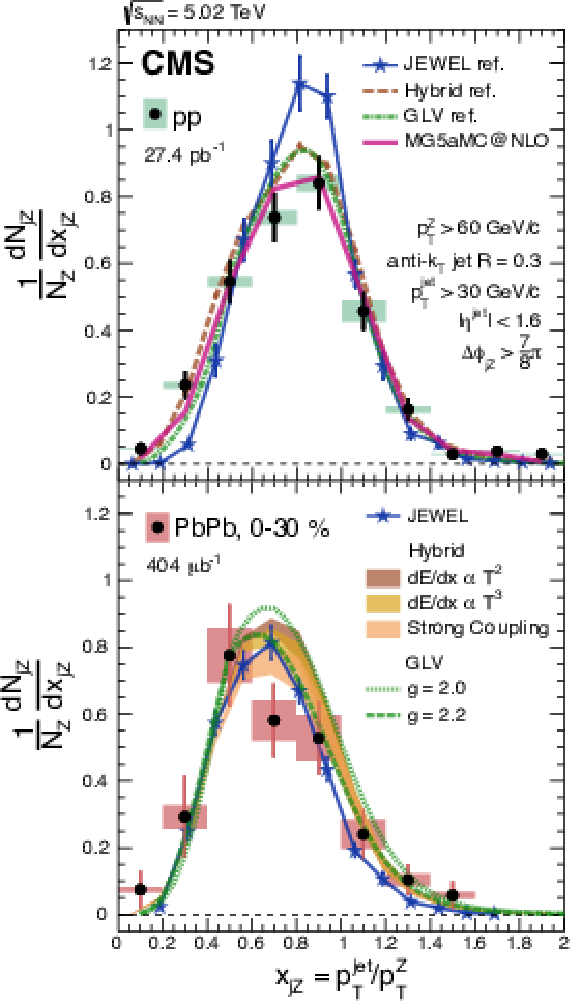
png pdf |
Figure 4:
Comparison of the measured pp (top) and PbPb (bottom) ${x_{\mathrm {jZ}}} $ distributions with several theoretical models, smeared by the respective jet energy resolution: JEWEL [26], Hybrid [25], and GLV [27]. The JEWEL error bars represent statistical uncertainties while the widths of the Hybrid bands represent systematic variations. A MadGraph5_amc@nlo calculation [36] is also shown. |
| Summary |
| In summary, correlations of $ p_{\mathrm{T}}^{\mathrm{Z}} > $ 40 GeV/$c$ Z bosons with $ p_{\mathrm{T}}^{\text{jet}} > $ 30 GeV/$c$ jets have been studied in pp and, for the first time, in PbPb collisions. The data were collected with the CMS experiment during the 2015 data taking period, at $\sqrt{ s_{\mathrm{NN}} } = $ 5.02 TeV. Distributions of the azimuthal angle difference between the Z and the jet suggest that the peak at $\Delta \phi_{\mathrm{jZ}} = \pi $ is slightly narrower in PbPb than in pp data, however significant differences were not established with the current precision. The $ x_{\mathrm{jZ}} $ distributions indicate that the PbPb values tend to be lower than those measured in pp collisions. Correspondingly, the average value of the transverse momentum ratio $ < x_{\mathrm{jZ}} > $ is smaller in PbPb than in pp collisions, for all $ p_{\mathrm{T}}^{\mathrm{Z}} $ intervals. The average number of jet partners per Z, $R_{\mathrm{jZ}}$, is lower in PbPb than in pp collisions, for all $ p_{\mathrm{T}}^{\mathrm{Z}} $ intervals, which suggests that in PbPb collisions a larger fraction of partons associated with the Z boson lose energy and fall below the 30 GeV/$c$ $ p_{\mathrm{T}}^{\text{jet}} $ threshold. These measurements provide new input for the determination of jet quenching parameters using a selection of partons with well-defined flavor and initial kinematics. |
| Additional Figures | |

png pdf |
Additional Figure 1:
Distributions of the transverse momentum ratio from Z+jet and photon+jet [50] correlations in PbPb collisions. |
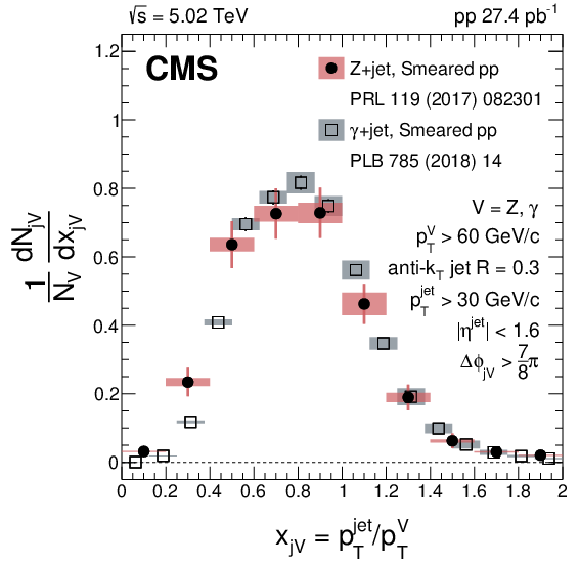
png pdf |
Additional Figure 2:
Distributions of the transverse momentum ratio from Z+jet and photon+jet [50] correlations in pp collisions. |

png pdf |
Additional Figure 3:
The mean value of the transverse momentum ratio distributions from Z+jet and photon+jet [50] correlations in PbPb collisions. |
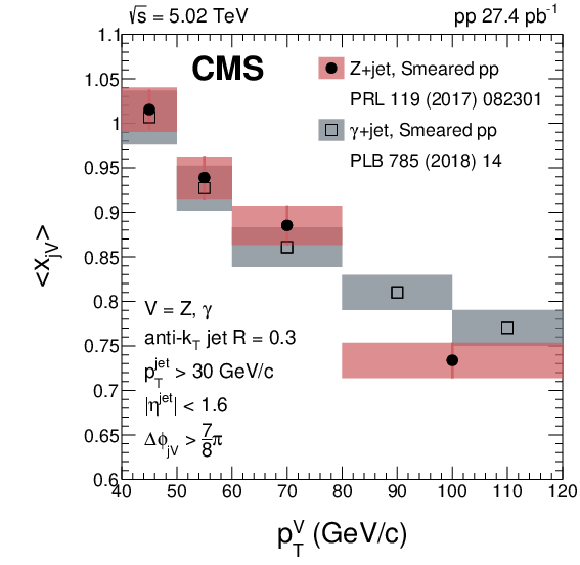
png pdf |
Additional Figure 4:
The mean value of the transverse momentum ratio distributions from Z+jet and photon+jet [50] correlations in pp collisions. |

png pdf |
Additional Figure 5:
The average number of jet partners per boson from Z+jet and photon+jet [50] correlations in PbPb collisions. |
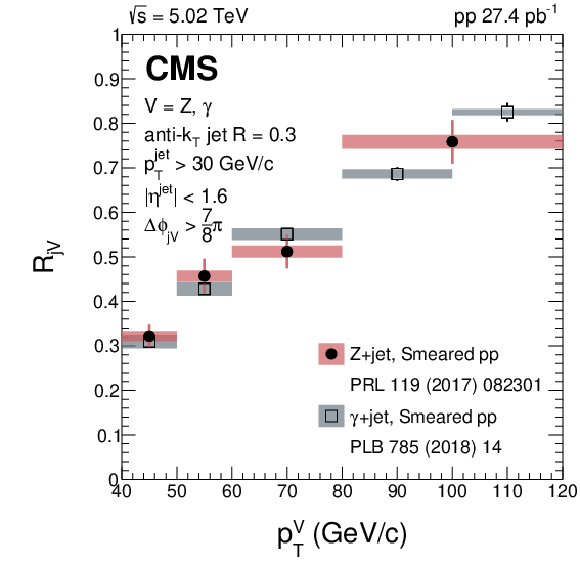
png pdf |
Additional Figure 6:
The average number of jet partners per boson from Z+jet and photon+jet [50] correlations in pp collisions. |

png pdf |
Additional Figure 7:
Comparison of the measured PbPb ${\Delta \phi _{\mathrm {jZ}}}$ (azimuthal angle difference between the Z boson and the jet) distributions with several theoretical models smeared by the jet energy resolution in PbPb : JEWEL [26] and Hybrid [25]. |
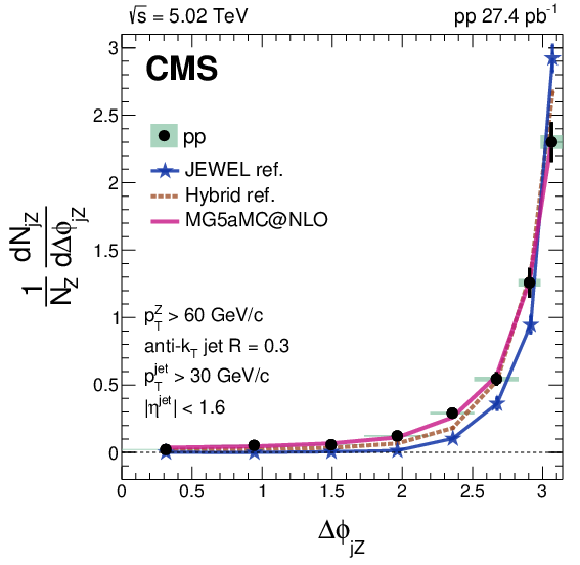
png pdf |
Additional Figure 8:
Comparison of the measured pp and ${\Delta \phi _{\mathrm {jZ}}}$ (azimuthal angle difference between the Z boson and the jet) distributions with several theoretical models smeared by the jet energy resolution in pp : JEWEL [26] and Hybrid [25]. The curve labeled MG5aMC@NLO represents the MadGraph5_aMC@NLO calculation [36]. |
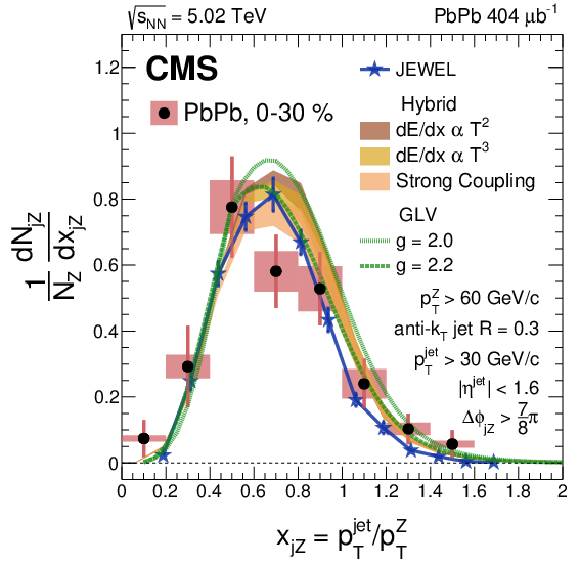
png pdf |
Additional Figure 9:
Comparison of the measured PbPb ${x_{\mathrm {jZ}}}$ (transverse momentum ratio) distributions with several theoretical models smeared by the jet energy resolution in PbPb : JEWEL [26], Hybrid [25], and GLV [27]. |
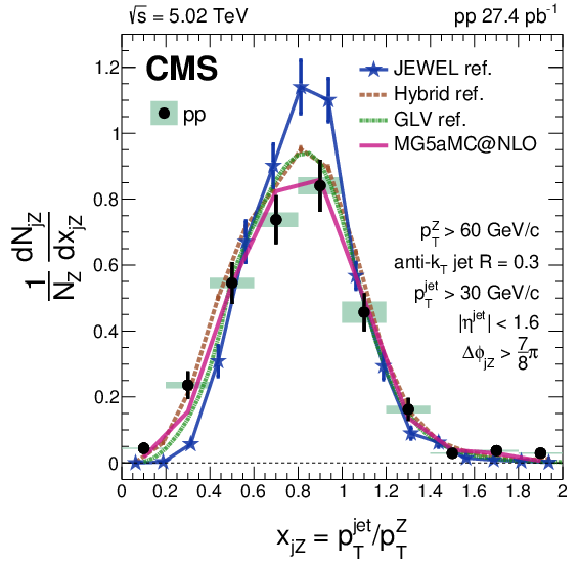
png pdf |
Additional Figure 10:
Comparison of the measured pp and ${x_{\mathrm {jZ}}}$ (transverse momentum ratio) distributions with several theoretical models smeared by the jet energy resolution in pp : JEWEL [26], Hybrid [25], and GLV [27]. The curve labeled MG5aMC@NLO represents the MadGraph5_aMC@NLO calculation [36]. |

png pdf |
Additional Figure 11:
The mean value of the $ {x_{\mathrm {jZ}}} $ distribution as a function of $ {p_{\mathrm {T}}^{{\mathrm {Z}}}} $ in PbPb collisions are compared to predictions from JEWEL [26]. |

png pdf |
Additional Figure 12:
The mean value of the $ {x_{\mathrm {jZ}}} $ distribution as a function of $ {p_{\mathrm {T}}^{{\mathrm {Z}}}} $ in pp collisions are compared to predictions from JEWEL [26] and MadGraph5_aMC@NLO calculation [36]. |
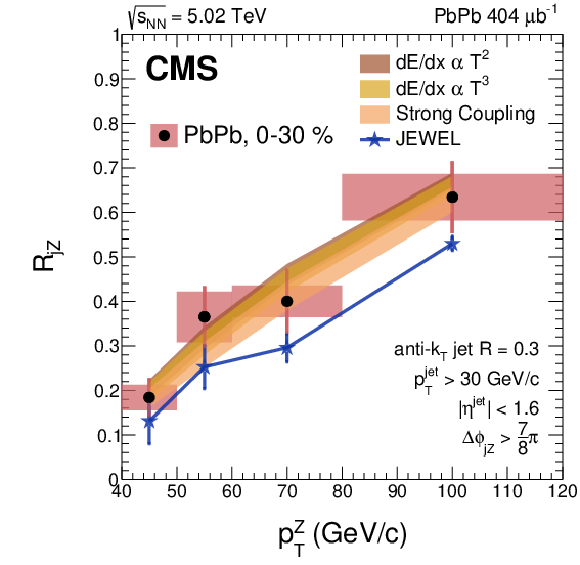
png pdf |
Additional Figure 13:
The average number of jet partners per Z boson $ {R_{\mathrm {jZ}}} $ as a function of $ {p_{\mathrm {T}}^{{\mathrm {Z}}}} $ in PbPb collisions are compared to predictions from Hybrid model [25] and JEWEL [26]. |

png pdf |
Additional Figure 14:
The average number of jet partners per Z boson $ {R_{\mathrm {jZ}}} $ as a function of $ {p_{\mathrm {T}}^{{\mathrm {Z}}}} $ in pp collisions are compared to predictions from Hybrid model [25], JEWEL [26], and MadGraph5_aMC@NLO calculation [36]. |
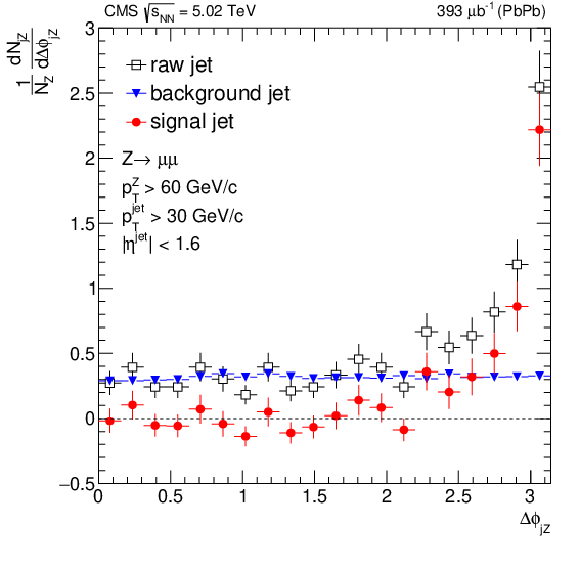
png pdf |
Additional Figure 15:
${\Delta \phi _{\mathrm {jZ}}}$ (azimuthal angle difference between the Z boson and the jet) in PbPb collisions before (open squares) and after (red circles) background subtraction where the background (blue triangles) is estimated with the mixed event method. |
| References | ||||
| 1 | E. V. Shuryak | Quark-Gluon Plasma and hadronic production of leptons, photons and pions | PLB 78 (1978) 150 | |
| 2 | E. V. Shuryak | What RHIC experiments and theory tell us about properties of quark-gluon plasma? | NP A 750 (2005) 64 | hep-ph/0405066 |
| 3 | D. A. Appel | Jets as a probe of quark-gluon plasmas | PRD 33 (1986) 717 | |
| 4 | J. P. Blaizot and L. D. McLerran | Jets in expanding quark-gluon plasmas | PRD 34 (1986) 2739 | |
| 5 | M. Gyulassy and M. Plumer | Jet quenching in dense matter | PLB 243 (1990) 432 | |
| 6 | X.-N. Wang and M. Gyulassy | Gluon shadowing and jet quenching in A+A collisions at $ \sqrt{s} = $ 200A GeV | PRL 68 (1992) 1480 | |
| 7 | R. Baier et al. | Radiative energy loss and $ {p_{\mathrm{T}}} $ broadening of high-energy partons in nuclei | NPB 484 (1997) 265 | hep-ph/9608322 |
| 8 | B. G. Zakharov | Radiative energy loss of high-energy quarks in finite-size nuclear matter and quark-gluon plasma | JEPTL 65 (1997) 615 | hep-ph/9704255 |
| 9 | J. Casalderrey-Solana and C. A. Salgado | Introductory lectures on jet quenching in heavy ion collisions | Acta Phys. Polon. B 38 (2007) 3731 | 0712.3443 |
| 10 | D. d'Enterria | Jet quenching | in Relativistic Heavy Ion Physics, R. Stock, ed., volume 23, 2010 Landolt-Börnstein/SpringerMaterials | 0902.2011 |
| 11 | U. A. Wiedemann | Jet Quenching in Heavy Ion Collisions | in Relativistic Heavy Ion Physics, R. Stock, ed., volume 23, p. 521 2010 Landolt-B\"ornstein/SpringerMaterials | 0908.2306 |
| 12 | STAR Collaboration | Direct observation of dijets in central Au+Au collisions at $ {\sqrt {\smash [b]{s_{_{\mathrm {NN}}}}}} = $ 200 GeV | PRL 97 (2006) 162301 | nucl-ex/0604018 |
| 13 | PHENIX Collaboration | Transverse momentum and centrality dependence of dihadron correlations in Au+Au collisions at $ \{\sqrt {\smash [b]{s_{_{\mathrm {NN}}}}}}= $ 200 gev: Jet quenching and the response of partonic matter | PRC 77 (2008) 011901 | 0705.3238 |
| 14 | ATLAS Collaboration | Observation of a centrality-dependent dijet asymmetry in lead-lead collisions at $ {\sqrt {\smash [b]{s_{_{\mathrm {NN}}}}}}= $ 2.76 TeV with the ATLAS detector at the LHC | PRL 105 (2010) 252303 | 1011.6182 |
| 15 | CMS Collaboration | Observation and studies of jet quenching in PbPb collisions at $ {\sqrt {\smash [b]{s_{_{\mathrm {NN}}}}}}= $ 2.76 TeV | PRC 84 (2011) 024906 | CMS-HIN-10-004 1102.1957 |
| 16 | CMS Collaboration | Jet momentum dependence of jet quenching in PbPb collisions at $ {\sqrt {\smash [b]{s_{_{\mathrm {NN}}}}}}= $ 2.76 TeV | PLB 712 (2012) 176 | CMS-HIN-11-013 1202.5022 |
| 17 | CMS Collaboration | Studies of jet quenching using isolated-photon + jet correlations in PbPb and pp collisions at $ {\sqrt {\smash [b]{s_{_{\mathrm {NN}}}}}}= $ 2.76 TeV | PLB 718 (2013) 773 | CMS-HIN-11-010 1205.0206 |
| 18 | ALICE Collaboration | Measurement of jet suppression in central Pb--Pb collisions at $ {\sqrt {\smash [b]{s_{_{\mathrm {NN}}}}}}= $ 2.76 TeV | PLB 746 (2015) 1 | 1502.01689 |
| 19 | V. Kartvelishvili, R. Kvatadze, and R. Shanidze | On Z and Z + jet production in heavy ion collisions | PLB 356 (1995) 589 | hep-ph/9505418 |
| 20 | R. B. Neufeld and I. Vitev | The $ Z^0 $-tagged jet event asymmetry in heavy-ion collisions at the CERN Large Hadron Collider | PRL 108 (2012) 242001 | 1202.5556 |
| 21 | R. B. Neufeld, I. Vitev, and B. W. Zhang | Physics of $ Z^0/\gamma^* $-tagged jets at energies available at the CERN Large Hadron Collider | PRC 83 (2011) 034902 | 1006.2389 |
| 22 | J. Casalderrey-Solana, Y. Mehtar-Tani, C. A. Salgado, and K. Tywoniuk | New picture of jet quenching dictated by color coherence | PL725 (2013) 357 | 1210.7765 |
| 23 | JET Collaboration | Extracting the jet transport coefficient from jet quenching in high-energy heavy-ion collisions | PRC 90 (2014) 014909 | 1312.5003 |
| 24 | J. Casalderrey-Solana et al. | A hybrid strong/weak coupling approach to jet quenching | JHEP 10 (2014) 019 | 1405.3864 |
| 25 | J. Casalderrey-Solana et al. | Predictions for boson-jet observables and fragmentation function ratios from a hybrid strong/weak coupling model for jet quenching | JHEP 03 (2016) 053 | 1508.00815 |
| 26 | R. Kunnawalkam Elayavalli and K. C. Zapp | Simulating V+jet processes in heavy ion collisions with JEWEL | EPJC 76 (2016) 695 | 1608.03099 |
| 27 | Z.-B. Kang, I. Vitev, and H. Xing | Vector boson-tagged jet production in heavy ion collisions at the LHC | 1702.07276 | |
| 28 | X.-N. Wang, Z. Huang, and I. Sarcevic | Jet quenching in the direction opposite to a tagged photon in high-energy heavy-ion collisions | PRL 77 (1996) 231 | hep-ph/9605213 |
| 29 | X.-N. Wang and Z. Huang | Medium-induced parton energy loss in $ \gamma $+jet events of high-energy heavy-ion collisions | PRC 55 (1997) 3047 | hep-ph/9701227 |
| 30 | CMS Collaboration | Measurement of isolated photon production in pp and PbPb collisions at $ {\sqrt {\smash [b]{s_{_{\mathrm {NN}}}}}}= $ 2.76 TeV | PLB 710 (2012) 256 | CMS-HIN-11-002 1201.3093 |
| 31 | CMS Collaboration | The CMS experiment at the CERN LHC | JINST 3 (2008) S08004 | CMS-00-001 |
| 32 | CMS Collaboration | Charged-particle nuclear modification factors in PbPb and pPb collisions at $ {\sqrt {\smash [b]{s_{_{\mathrm {NN}}}}}}= $ 5.02 TeV | Submitted to JHEP | CMS-HIN-15-015 1611.01664 |
| 33 | CMS Collaboration | The CMS trigger system | JINST 12 (2017) P01020 | CMS-TRG-12-001 1609.02366 |
| 34 | T. Sjostrand, S. Mrenna, and P. Z. Skands | A brief introduction to PYTHIA 8.1 | CPC 178 (2008) 852 | 0710.3820 |
| 35 | CMS Collaboration | Event generator tunes obtained from underlying event and multiparton scattering measurements | EPJC 76 (2016), no. 3, 155 | CMS-GEN-14-001 1512.00815 |
| 36 | J. Alwall et al. | The automated computation of tree-level and next-to-leading order differential cross sections, and their matching to parton shower simulations | JHEP 07 (2014) 079 | 1405.0301 |
| 37 | I. P. Lokhtin and A. M. Snigirev | A model of jet quenching in ultrarelativistic heavy ion collisions and high-$ {p_{\mathrm{T}}} $ hadron spectra at RHIC | EPJC 45 (2006) 211 | hep-ph/0506189 |
| 38 | GEANT4 Collaboration | GEANT4---a simulation toolkit | NIMA 506 (2003) 250 | |
| 39 | CMS Collaboration | Performance of electron reconstruction and selection with the CMS detector in proton-proton collisions at $ \sqrt{s}= $ 8 TeV | JINST 10 (2015) P06005 | CMS-EGM-13-001 1502.02701 |
| 40 | CMS Collaboration | Performance of CMS muon reconstruction in pp collision events at $ \sqrt{s}= $ 7 TeV | JINST 7 (2012) P10002 | CMS-MUO-10-004 1206.4071 |
| 41 | M. Cacciari, G. P. Salam, and G. Soyez | FastJet user manual | EPJC 72 (2012) 1896 | 1111.6097 |
| 42 | O. Kodolova, I. Vardanian, A. Nikitenko, and A. Oulianov | The performance of the jet identification and reconstruction in heavy ions collisions with CMS detector | EPJC 50 (2007) 117 | |
| 43 | CMS Collaboration | Determination of jet energy calibration and transverse momentum resolution in cms | JINST 6 (2011) P11002 | CMS-JME-10-011 1107.4277 |
| 44 | CMS Collaboration | Measurement of transverse momentum relative to dijet systems in PbPb and pp collisions at $ {\sqrt {\smash [b]{s_{_{\mathrm {NN}}}}}}= $ 2.76 TeV | JHEP 01 (2016) 006 | CMS-HIN-14-010 1509.09029 |
| 45 | M. Cacciari, J. Rojo, G. P. Salam, and G. Soyez | Jet reconstruction in heavy ion collisions | EPJC 71 (2011) 1 | 1010.1759 |
| 46 | M. Cacciari and G. P. Salam | Pileup subtraction using jet areas | PLB 659 (2008) 119 | 0707.1378 |
| 47 | F. James | Statistical methods in experimental physics | Hackensack, USA: World Scientific,2006ISBN-9789812567956 | |
| 48 | I. Vitev | SCET for jet physics in the vacuum and the medium | 1612.09226 | |
| 49 | Y.-T. Chien and I. Vitev | Towards the understanding of jet shapes and cross sections in heavy ion collisions using soft-collinear effective theory | JHEP 05 (2016) 023 | 1509.07257 |
| 50 | CMS Collaboration | Study of jet quenching with isolated-photon+jet correlations in PbPb and pp collisions at $ {\sqrt {\smash [b]{s_{_{\mathrm {NN}}}}}} = $ 5.02 TeV | PLB 785 (2018) 14 | CMS-HIN-16-002 1711.09738 |

|
Compact Muon Solenoid LHC, CERN |

|

|

|

|

|

|